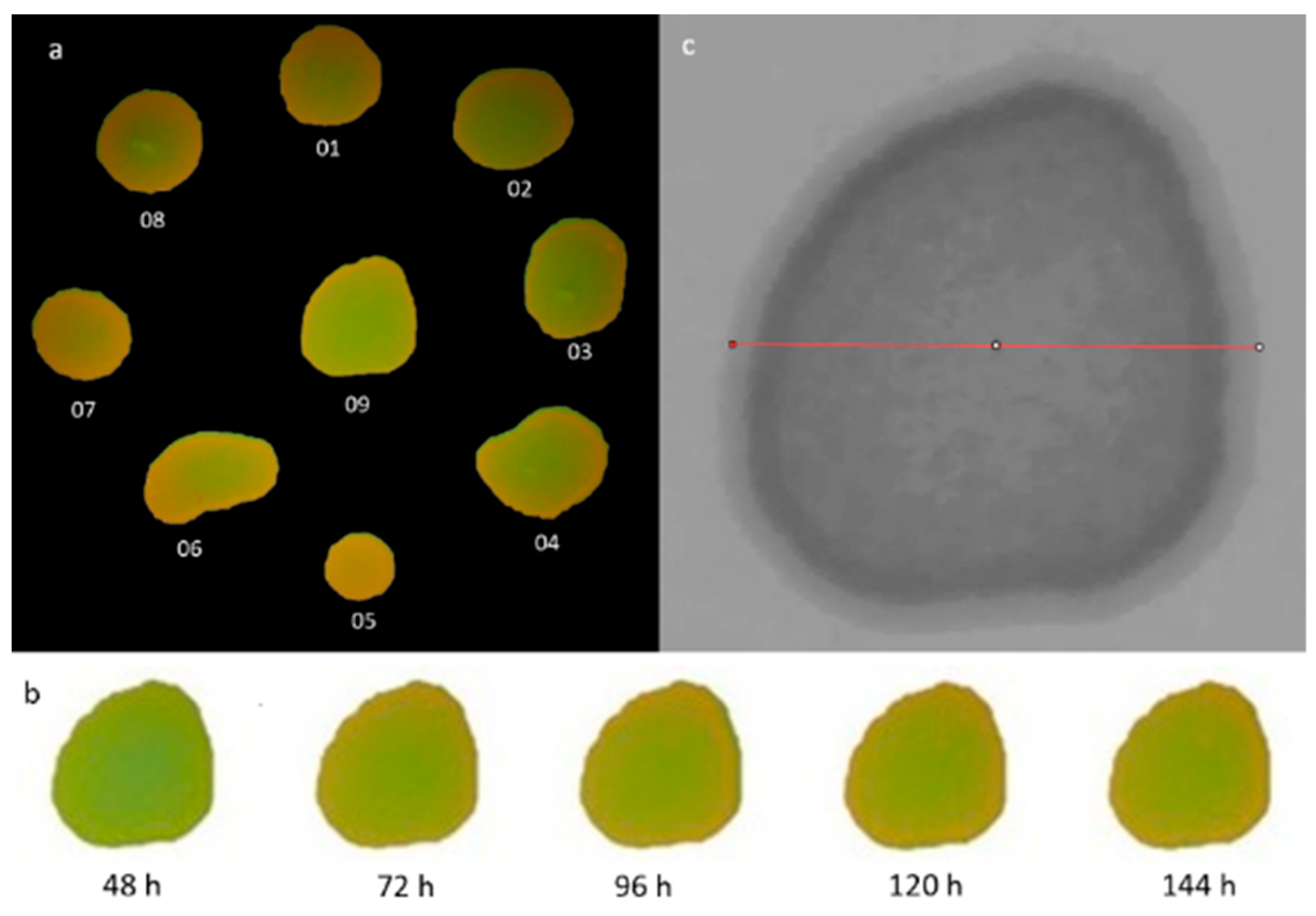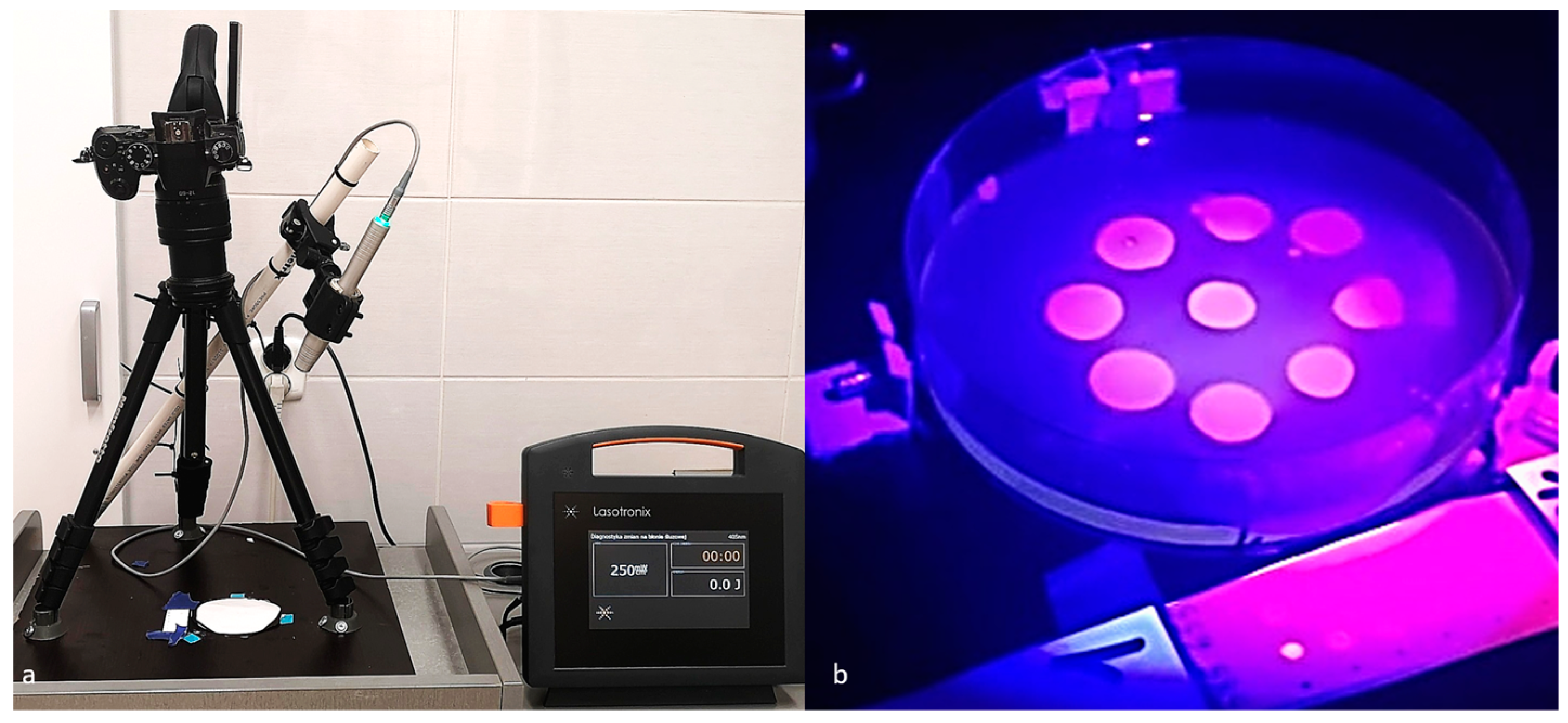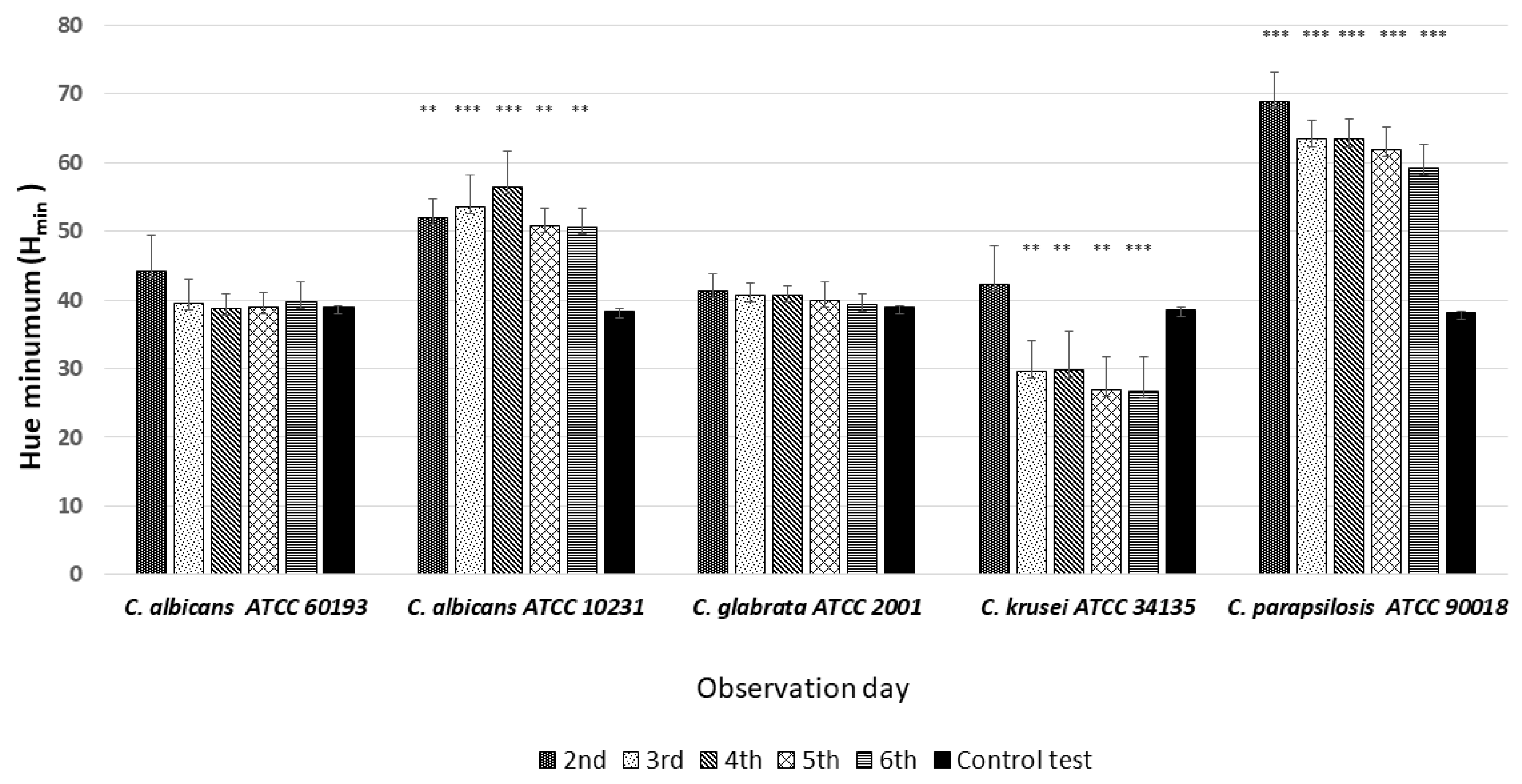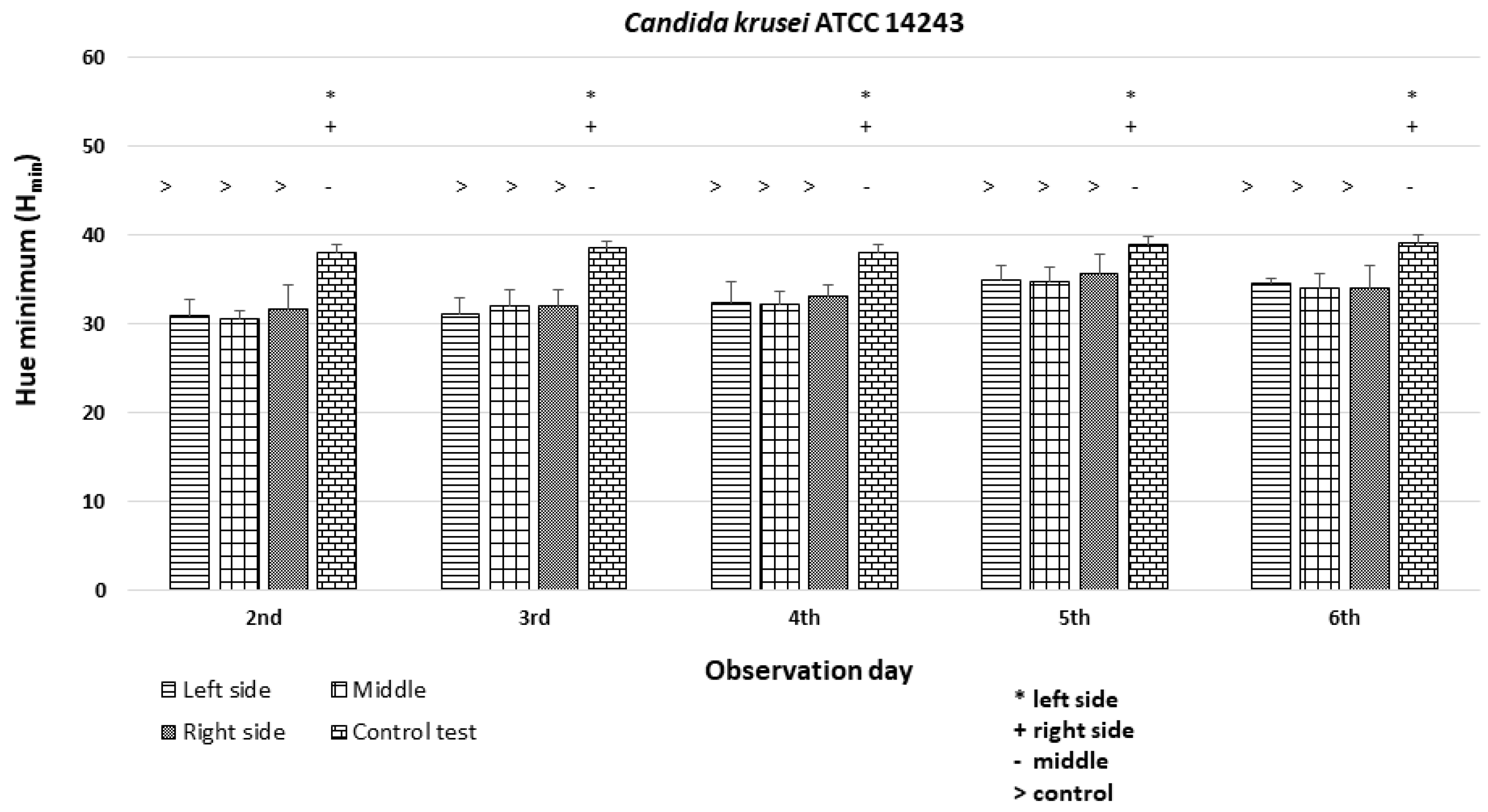Red/Orange Autofluorescence in Selected Candida Strains Exposed to 405 nm Laser Light
Abstract
1. Introduction
- Normal healthy tissue emitting a pale green fluorescence.
- Loss of fluorescence (LOF), distinguished by a dark brown to black mucosal area and typically associated with dysplastic and/or neoplastic tissues.
- Gained fluorescence (GF), commonly observed in hyperkeratotic lesions like leukoplakia.
2. Materials and Methods
2.1. Fungal Strains
2.2. Inoculum Preparation
2.3. Study Groups and Culture Conditions
2.3.1. Study Groups
2.3.2. Control Group
2.3.3. Light Source
2.4. Qualitative Visual Assessment of Images
2.5. Quantification of Colony Minimum and Maximum Hue Values
2.6. Electronic Analysis of Intra-Colony Hue Distribution
2.7. Statistical Analyses
3. Results
3.1. Visual Assessment of Colony Growth and Sample Contamination
3.2. Qualitative Assessment of Autofluorescence
3.3. Quantitative Colony Hue Analysis—Electronic Evaluation
3.4. Electronic Analysis of Intra-Colony Hue Distribution
4. Discussion
Limitations and Future Research
5. Conclusions
6. Clinical Significance
Author Contributions
Funding
Institutional Review Board Statement
Informed Consent Statement
Data Availability Statement
Conflicts of Interest
References
- Mbakwem-Aniebo, C.; Osadebe, A.U.; Athanasonny, E.; Okonko, I.O. Prevalence of Candida spp. and Age-Related Disparities Amongst Women Presenting with Vaginitis at the Obstetrics and Gynaecology (O&G) Clinic in a Tertiary Hospital in Port Harcourt, Nigeria. Afr. Health Sci. 2020, 20, 51–58. [Google Scholar]
- Zafar, S.; Fatima, K.; Faryal, R. Prevalence of Virulent candida spp. in Complicated Urinary Tract Infection of Nephrolithiatic Patients from Surgical Units of Tertiary Care Hospitals Islamabad. J. Mycol. Med. 2020, 30, 101024. [Google Scholar] [CrossRef]
- Wiench, R.; Skaba, D.; Matys, J.; Grzech-Leśniak, K. Efficacy of Toluidine Blue-Mediated Antimicrobial Photodynamic Therapy on Candida spp. A Systematic Review. Antibiotics 2021, 10, 349. [Google Scholar] [CrossRef]
- Beighton, D.; Lynch, E. Relationships between Yeasts and Primary Root-Caries Lesions. Gerodontology 1993, 10, 105–108. [Google Scholar] [CrossRef]
- Pappas, P.G.; Lionakis, M.S.; Arendrup, M.C.; Ostrosky-Zeichner, L.; Kullberg, B.J. Invasive Candidiasis. Nat. Rev. Dis. Primers 2018, 4, 18026. [Google Scholar] [CrossRef]
- Segrelles-Calvo, G.; de SAraújo, G.R.; Llopis-Pastor, E.; Carrillo, J.; Hernández-Hernández, M.; Rey, L.; Melean, N.R.; Escribano, I.; Antón, E.; Zamarro, C.; et al. Candida spp. co-infection in COVID-19 patients with severe pneumonia: Prevalence study and associated risk factors. Respir. Med. 2021, 188, 106619. [Google Scholar] [CrossRef]
- Freitas, V.A.Q.; Santos, A.S.; Zara, A.L.S.A.; Costa, C.R.; Godoy, C.S.M.; Soares, R.B.A.; Ataídes, F.S.; Silva, M.D.R.R. Distribution and antifungal susceptibility profiles of Candida species isolated from people living with HIV/AIDS in a public hospital in Goiânia, GO, Brazil. Braz. J. Microbiol. 2023, 54, 125–133. [Google Scholar] [CrossRef]
- Akpan, A.; Morgan, R. Oral Candidiasis. Postgrad. Med. J. 2002, 78, 455–459. [Google Scholar] [CrossRef]
- Tasso, C.O.; Ferrisse, T.M.; de Oliveira, A.B.; Ribas, B.R.; Jorge, J.H. Candida Species as Potential Risk Factors for Oral Squamous Cell Carcinoma: Systematic Review and Meta-Analysis. Cancer Epidemiol. 2023, 86, 102451. [Google Scholar] [CrossRef] [PubMed]
- Silva, S.; Negri, M.; Henriques, M.; Oliveira, R.; Williams, D.W.; Azeredo, J. Candida glabrata, Candida parapsilosis and Candida tropicalis: Biology, Epidemiology, Pathogenicity and Antifungal Resistance. FEMS Microbiol. Rev. 2012, 36, 288–305. [Google Scholar] [CrossRef] [PubMed]
- Graus, M.S.; Neumann, A.K.; Timlin, J.A. Hyperspectral Fluorescence Microscopy Detects Autofluorescent Factors That Can Be Exploited as a Diagnostic Method for Candida Species Differentiation. J. Biomed. Opt. 2017, 22, 16002. [Google Scholar] [CrossRef] [PubMed]
- Kobayashi, T.; Saito, T.; Ohtani, H. Real-Time Spectroscopy of Transition States in Bacteriorhodopsin During Retinal Isomerization. Nature 2001, 414, 531–534. [Google Scholar] [CrossRef]
- Petruzzi, M.; Della Vella, F.; Cassandro, A.; Mosca, A.; Di Comite, M.; Contaldo, M.; Grassi, F.R.; Lauritano, D. Dorsal Tongue Porphyrin Autofluorescence and Candida Saprophytism: A Prospective Observational Study. PLoS ONE 2019, 14, e0223072. [Google Scholar] [CrossRef]
- Lane, P.M.; Gilhuly, T.; Whitehead, P.; Zeng, H.; Poh, C.F.; Ng, S.; Williams, P.M.; Zhang, L.; Rosin, M.P.; MacAulay, C.E. Simple Device for the Direct Visualization of Oral-Cavity Tissue Fluorescence. J. Biomed. Opt. 2006, 11, 024006. [Google Scholar] [CrossRef] [PubMed]
- Na, R.; Stender, I.M.; Henriksen, M.; Wulf, H.C. Autofluorescence of Human Skin is Age-Related After Correction for Skin Pigmentation and Redness. J. Investig. Dermatol. 2001, 116, 536–540. [Google Scholar] [CrossRef]
- Plavskii, V.Y.; Mikulich, A.V.; Tretyakova, A.I.; Leusenka, I.A.; Plavskaya, L.G.; Kazyuchits, O.A.; Dobysh, I.I.; Krasnenkova, T.P. Porphyrins and Flavins as Endogenous Acceptors of Optical Radiation of Blue Spectral Region Determining Photoinactivation of Microbial Cells. J. Photochem. Photobiol. B 2018, 183, 172–183. [Google Scholar] [CrossRef]
- De Veld, D.C.G.; Witjes, M.J.H.; Sterenborg, H.J.C.M.; Roodenburg, J.L.N. The Status of In Vivo Autofluorescence Spectroscopy and Imaging for Oral Oncology. Oral Oncol. 2005, 14, 117–131. [Google Scholar] [CrossRef] [PubMed]
- McAlpine, J.N.; El Hallani, S.; Lam, S.F.; Kalloger, S.E.; Luk, M.; Huntsman, D.G.; MacAulay, C.; Gilks, C.B.; Miller, D.M.; Lane, P.M. Autofluorescence Imaging Can Identify Preinvasive or Clinically Occult Lesions in Fallopian Tube Epithelium: A Promising Step Towards Screening and Early Detection. Gynecol. Oncol. 2011, 120, 385–392. [Google Scholar] [CrossRef]
- Volgenant, C.M.; van der Veen, M.H.; de Soet, J.J.; ten Cate, J.M. Effect of Metalloporphyrins on Red Autofluorescence from Oral Bacteria. Eur. J. Oral Sci. 2013, 121 Pt 1, 156–161. [Google Scholar] [CrossRef]
- Volgenant, C.M.; Hoogenkamp, M.A.; Krom, B.P.; Janus, M.M.; Ten Cate, J.M.; de Soet, J.J.; Crielaard, W.; van der Veen, M.H. Red and Green Fluorescence from Oral Biofilms. PLoS ONE 2016, 11, e0168428. [Google Scholar] [CrossRef]
- de Veld, D.C.; Skurichina, M.; Witjes, M.J.; Duin, R.P.W.; Sterenborg, D.J.C.M.; Star, W.M.; Roodenburg, J.L.N. Autofluorescence Characteristics of Healthy Oral Mucosa at Different Anatomical Sites. Lasers Surg. Med. 2003, 32, 367–376. [Google Scholar] [CrossRef]
- van der Veen, M.H.; Volgenant, C.M.C.; Keijser, B.; Jacob Bob, M.; Crielaard, W. Dynamics of Red Fluorescent Dental Plaque during Experimental Gingivitis—A Cohort Study. J. Dent. 2016, 48, 71–76. [Google Scholar] [CrossRef] [PubMed]
- Oriel, S.; Nitzan, Y. Photoinactivation of Candida albicans by Its Own Endogenous Porphyrins. Curr. Microbiol. 2010, 60, 117–123. [Google Scholar] [CrossRef] [PubMed]
- Fraikin, Y.; Strakhovskaya, M.G.; Rubin, A.B. The Role of Membrane-Bound Porphyrin-Type Compound as Endogenous Sensitizer in Photodynamic Damage to Yeast Plasma Membranes. J. Photochem. Photobiol. B 1996, 34, 129–135. [Google Scholar] [CrossRef]
- Zhang, Y.; Zhu, Y.; Chen, J.; Wang, Y.; Sherwood, M.E.; Murray, C.K.; Vrahas, M.S.; Hooper, D.C.; Hamblin, M.R.; Dai, T. Antimicrobial Blue Light Inactivation of Candida albicans: In Vitro and In Vivo Studies. Virulence 2016, 7, 536–545. [Google Scholar] [CrossRef] [PubMed]
- Murdoch, L.E.; McKenzie, K.; Maclean, M.; Macgregor, S.J.; Anderson, J.G. Lethal Effects of High-Intensity Violet 405-nm Light on Saccharomyces cerevisiae, Candida albicans, and on Dormant and Germinating Spores of Aspergillus niger. Fungal Biol. 2013, 117, 519–527. [Google Scholar] [CrossRef]
- Hu, L.; He, C.; Zhao, C.; Chen, X.; Hua, H.; Yan, Z. Characterization of Oral Candidiasis and the Candida Species Profile in Patients with Oral Mucosal Diseases. Microb. Pathog. 2019, 134, 103575. [Google Scholar] [CrossRef]
- Vadivel, A.; Sural, S.; Majumdar, A.K. Human Color Perception in the HSV Space and Its Application in Histogram Generation for Image Retrieval. Color Imaging X Process. Hardcopy Appl. 2005, 5667, 598–609. [Google Scholar]
- Kurniastuti, I.; Yuliati, E.N.I.; Yudianto, F.; Wulan, T.D. Determination of Hue Saturation Value (HSV) Color Feature in Kidney Histology Image. J. Phys. Conf. Ser. 2022, 2157, 012020. [Google Scholar] [CrossRef]
- Xia, Y.-M.; Wang, Q.-S.; Feng, X.; Xiao, X.-A.; Wang, Y.-Q.; Xu, Z.-X. Objective Tongue Diagnosis Based on HSV Color Space: Controlled Study of Tongue Appearance in Patients Treated with Percutaneous Coronary Intervention for Coronary Heart Disease. Intell. Med. 2022, 3, 252–257. [Google Scholar] [CrossRef]
- Satrya, G.B.; Ramatryana, I.N.A.; Shin, S.Y. Compressive Sensing of Medical Images Based on HSV Color Space. Sensors 2023, 23, 2616. [Google Scholar] [CrossRef]
- Liu, G.-H.; Wei, Z. Image Retrieval Using the Fused Perceptual Color Histogram. Comput. Intell. Neurosci. 2020, 2020, 876480. [Google Scholar] [CrossRef] [PubMed]
- Zhong, H.; Wang, R. A Visual-Degradation-Inspired Model with HSV Color-Encoding for Contour Detection. J. Neurosci. Methods 2022, 369, 109423. [Google Scholar] [CrossRef] [PubMed]
- Kimball, S.; Mattis, P.; GIMP Team. GNU Image Manipulation Program. 1995–2023. Available online: https://www.gimp.org/ (accessed on 20 April 2022).
- Rasband, W.S. ImageJ; U.S. National Institutes of Health: Bethesda, MA, USA, 1997–2018. Available online: https://imagej.nih.gov/ij/ (accessed on 20 April 2022).
- Harris, D.M.; Werkhaven, J. Endogenous Porphyrin Fluorescence in Tumors. Lasers Surg. Med. 1987, 7, 467–472. [Google Scholar] [CrossRef] [PubMed]
- Onizawa, K.; Saginoya, H.; Furuya, Y.; Yoshida, H. Fluorescence Photography as a Diagnostic Method for Oral Cancer. Cancer Lett. 1996, 108, 61–66. [Google Scholar] [CrossRef] [PubMed]
- Onizawa, K.; Saginoya, H.; Furuya, Y.; Yoshida, H.; Fukuda, H. Usefulness of Fluorescence Photography for Diagnosis of Oral Cancer. Int. J. Oral Maxillofac. Surg. 1999, 28, 206–210. [Google Scholar] [CrossRef] [PubMed]
- Onizawa, K.; Yoshida, H.; Saginoya, H. Chromatic Analysis of Autofluorescence Emitted from Squamous Cell Carcinomas Arising in the Oral Cavity: A Preliminary Study. Int. J. Oral Maxillofac. Surg. 2000, 29, 42–46. [Google Scholar] [CrossRef] [PubMed]
- Betz, C.S.; Mehlmann, M.; Rick, K.; Stepp, H.; Grevers, G.; Baumgartner, R.; and Leunig, A. Autofluorescence Imaging and Spectroscopy of Normal and Malignant Mucosa in Patients with Head and Neck Cancer. Lasers Surg. Med. 1999, 25, 323–334. [Google Scholar] [CrossRef]
- Tang, B.H.E.; Bay, J.W.; Yeong, F.M.; Samuel, M. Efficacy and Safety of Echinocandin Monotherapy and Combination Therapy for Immunocompromised Patients with Systemic Candidiasis: A Systematic Review and Meta-Analysis. J. Mycol. Med. 2023, 33, 101362. [Google Scholar] [CrossRef]
- Orlandini, R.K.; Bepu, D.A.N.; Saraiva, M.D.C.P.; Bollela, V.R.; Motta, A.C.F.; Lourenço, A.G. Are Candida albicans Isolates from the Oral Cavity of HIV-Infected Patients More Virulent than from Non-HIV-Infected Patients? Systematic Review and Meta-Analysis. Microb. Pathog. 2020, 149, 104477. [Google Scholar] [CrossRef]
- Lorenzo-Pouso, A.I.; Pérez-Jardón, A.; Caponio, V.C.A.; Spirito, F.; Chamorro-Petronacci, C.M.; Álvarez-Calderón-Iglesias, Ó.; Gándara-Vila, P.; Lo Muzio, L.; Pérez-Sayáns, M. Oral Chronic Hyperplastic Candidiasis and Its Potential Risk of Malignant Transformation: A Systematic Review and Prevalence Meta-Analysis. J. Fungi 2022, 8, 1093. [Google Scholar] [CrossRef]
- Kang, S.M.; de Josselin de Jong, E.; Higham, S.M.; Hope, C.K.; Kim, B.I. Fluorescence Fingerprints of Oral Bacteria. J. Biophotonics 2020, 13, e201900190. [Google Scholar] [CrossRef] [PubMed]
- Lee, M.A.; Kang, S.M.; Kim, S.Y.; Kim, J.S.; Kim, J.B.; Jeong, S.H. Fluorescence Change of Fusobacterium nucleatum due to Porphyromonas gingivalis. J. Microbiol. 2018, 56, 628–633. [Google Scholar] [CrossRef] [PubMed]
- van der Veen, M.H.; Thomas, R.Z.; Huysmans, M.C.; de Soet, J.J. Red Autofluorescence of Dental Plaque Bacteria. Caries Res. 2006, 40, 542–545. [Google Scholar] [CrossRef]
- Taga, M.E.; Bassler, B.L. Chemical Communication Among Bacteria. Proc. Natl. Acad. Sci. USA 2003, 100 (Suppl. S2), 14549–14554. [Google Scholar] [CrossRef]
- Jayaraman, A.; Wood, T.K. Bacterial Quorum Sensing: Signals, Circuits, and Implications for Biofilms and Disease. Annu. Rev. Biomed. Eng. 2008, 10, 145–167. [Google Scholar] [CrossRef]
- Smith, A.R. Color Gamut Transform Pairs. Comput. Graph. 1978, 12, 12–19. [Google Scholar] [CrossRef]
- Kim, Y.S.; Lee, E.S.; Kwon, H.K.; Kim, B.I. Monitoring the Maturation Process of a Dental Microcosm Biofilm Using the Quantitative Light-induced Fluorescence-Digital (QLF-D). J. Dent. 2014, 42, 691–696. [Google Scholar] [CrossRef]
- Chen, Q.; Zhu, H.; Xu, Y.; Lin, B.; Chen, H. Discrimination of Dental Caries Using Colorimetric Characteristics of Fluorescence Spectrum. Caries Res. 2015, 49, 401–407. [Google Scholar] [CrossRef]
- Lee, E.S.; Kang, S.M.; Ko, H.Y.; Kwon, H.K.; Kim, B.I. Association between the Cariogenicity of a Dental Microcosm Biofilm and Its Red Fluorescence Detected by Quantitative Light-induced Fluorescence-Digital (QLF-D). J. Dent. 2013, 41, 1264–1270. [Google Scholar] [CrossRef]
- Kumaraswamy Naik, L.R.; Shetty, P.; Krishna Prasad, M.S.; Karnaker, V.K.; Shroff, S.E.; Madathil, L.P. Fluorescence of Candida in Diagnosis of Oral Candidiasis. Indian J. Dent. Res. 2016, 27, 618–622. [Google Scholar] [CrossRef] [PubMed]
- Chinnasamy, A.; Ramalingam, K.; Nayak, S.; Rai, V.; Gopinath, V.; Chawla, G. Diagnostic Yield of Calcofluor White in the Identification of Candida albicans in Oral Squamous Cell Carcinoma. J. Oral Maxillofac. Pathol. 2022, 26, 366–369. [Google Scholar] [CrossRef] [PubMed]
- Bhavasar, R.S.; Goje, S.K.; Takalkar, A.A.; Ganvir, S.M.; Hazarey, V.K.; Gosavi, S.R. Detection of Candida by Calcofluor White. Acta Cytol. 2010, 54, 679–684. [Google Scholar] [CrossRef] [PubMed]
- Jin, Y.; Yip, H.K.; Samaranayake, Y.H.; Yau, J.Y.; Samaranayake, L.P. Biofilm-Forming Ability of Candida albicans is Unlikely to Contribute to High Levels of Oral Yeast Carriage in Cases of Human Immunodeficiency Virus Infection. J. Clin. Microbiol. 2003, 41, 2961–2967. [Google Scholar] [CrossRef] [PubMed]
- Rodaki, A.; Bohovych, I.M.; Enjalbert, B.; Young, T.; Odds, F.C.; Gow, N.A.R.; Brown, A.J.P. Glucose Promotes Stress Resistance in the Fungal Pathogen Candida albicans. Mol. Biol. Cell 2009, 20, 4845–4855. [Google Scholar] [CrossRef] [PubMed]
- Thein, Z.M.; Seneviratne, C.J.; Samaranayake, Y.H.; Samaranayake, L.P. Community Lifestyle of Candida in Mixed Biofilms: A Mini Review. Mycoses 2009, 52, 467–475. [Google Scholar] [CrossRef]
- Calderone, R.A.; Fonzi, W.A. Virulence Factors of Candida albicans. Trends Microbiol. 2001, 9, 327–335. [Google Scholar] [CrossRef]
- Kim, J.; Sudbery, P.E. Candida albicans, A Major Human Fungal Pathogen. J. Microbiol. 2011, 49, 171–177. [Google Scholar] [CrossRef]
- Biswas, S.; Van Dijck, P.; Datta, A. Environmental Sensing and Signal Transduction Pathways Regulating Morpho-pathogenic Determinants of Candida albicans. Microbiol. Mol. Biol. Rev. 2007, 71, 348–376. [Google Scholar] [CrossRef]
- Sudbery, P.E. Growth of Candida albicans Hyphae. Nat. Rev. Microbiol. 2011, 9, 737–748. [Google Scholar] [CrossRef]
- Chaffin, W.L. Candida albicans Cell Wall Proteins. Microbiol. Mol. Biol. Rev. 2008, 72, 495–544. [Google Scholar] [CrossRef] [PubMed]
- Gulati, M.; Nobile, C.J. Candida albicans Biofilms: Development, Regulation, and Molecular Mechanisms. Microbes Infect. 2016, 18, 310–321. [Google Scholar] [CrossRef] [PubMed]
- Lennon, A.M.; Buchalla, W.; Brune, L.; Zimmermann, O.; Gross, U.; Attin, T. The Ability of Selected Oral Microorganisms to Emit Red Fluorescence. Caries Res. 2006, 40, 2–5. [Google Scholar] [CrossRef] [PubMed]
- Lennon, Á.M.; Brune, L.; Techert, S.; Buchalla, W. Fluorescence Spectroscopy Shows Porphyrins Produced by Cultured Oral Bacteria Differ Depending on Composition of Growth Media. Caries Res. 2023, 57, 74–86. [Google Scholar] [CrossRef] [PubMed]
- Shu, M.; Kuo, S.; Wang, Y.; Jiang, Y.; Liu, Y.T.; Gallo, R.L.; Huang, C.M. Porphyrin Metabolisms in Human Skin Commensal Propionibacterium acnes Bacteria: Potential Application to Monitor Human Radiation Risk. Curr. Med. Chem. 2013, 20, 562–568. [Google Scholar]
- Barnard, E.; Johnson, T.; Ngo, T.; Arora, U.; Leuterio, G.; McDowell, A.; and Li, H. Porphyrin Production and Regulation in Cutaneous Propionibacteria. mSphere 2020, 5, e00793-19. [Google Scholar] [CrossRef]
- Hope, C.K.; Strother, M.; Creber, H.K.; Higham, S.M. Lethal Photosensitisation of Prevotellaceae under Anaerobic Conditions by Their Endogenous Porphyrins. Photodiagnosis Photodyn. Ther. 2016, 13, 344–346. [Google Scholar] [CrossRef]
- Rennie, M.Y.; Lindvere-Teene, L.; Tapang, K.; Linden, R. Point-of-Care Fluorescence Imaging Predicts the Presence of Pathogenic Bacteria in Wounds: A Clinical Study. J. Wound Care 2017, 26, 452–460. [Google Scholar] [CrossRef]
- Jones, L.M.; Dunham, D.; Rennie, M.Y.; Kirman, J.; Lopez, A.J.; Keim, K.C.; Little, W.; Gomez, A.; Bourke, J.; Ng, H.; et al. In vitro detection of porphyrin-producing wound bacteria with real-time fluores-cence imaging. Future Microbiol. 2020, 15, 319–332. [Google Scholar] [CrossRef]
- Rennie, M.Y.; Dunham, D.; Lindvere-Teene, L.; Raizman, R.; Hill, R.; Linden, R. Understanding Real-Time Fluorescence Signals from Bacteria and Wound Tissues Observed with the MolecuLight i:X™. Diagnostics 2019, 9, 22. [Google Scholar] [CrossRef] [PubMed]












Disclaimer/Publisher’s Note: The statements, opinions and data contained in all publications are solely those of the individual author(s) and contributor(s) and not of MDPI and/or the editor(s). MDPI and/or the editor(s) disclaim responsibility for any injury to people or property resulting from any ideas, methods, instructions or products referred to in the content. |
© 2024 by the authors. Licensee MDPI, Basel, Switzerland. This article is an open access article distributed under the terms and conditions of the Creative Commons Attribution (CC BY) license (https://creativecommons.org/licenses/by/4.0/).
Share and Cite
Wiench, R.; Paliga, D.; Mertas, A.; Bobela, E.; Kuśka-Kiełbratowska, A.; Bordin-Aykroyd, S.; Kawczyk-Krupka, A.; Grzech-Leśniak, K.; Lukomska-Szymanska, M.; Lynch, E.; et al. Red/Orange Autofluorescence in Selected Candida Strains Exposed to 405 nm Laser Light. Dent. J. 2024, 12, 48. https://doi.org/10.3390/dj12030048
Wiench R, Paliga D, Mertas A, Bobela E, Kuśka-Kiełbratowska A, Bordin-Aykroyd S, Kawczyk-Krupka A, Grzech-Leśniak K, Lukomska-Szymanska M, Lynch E, et al. Red/Orange Autofluorescence in Selected Candida Strains Exposed to 405 nm Laser Light. Dentistry Journal. 2024; 12(3):48. https://doi.org/10.3390/dj12030048
Chicago/Turabian StyleWiench, Rafał, Dariusz Paliga, Anna Mertas, Elżbieta Bobela, Anna Kuśka-Kiełbratowska, Sonia Bordin-Aykroyd, Aleksandra Kawczyk-Krupka, Kinga Grzech-Leśniak, Monika Lukomska-Szymanska, Edward Lynch, and et al. 2024. "Red/Orange Autofluorescence in Selected Candida Strains Exposed to 405 nm Laser Light" Dentistry Journal 12, no. 3: 48. https://doi.org/10.3390/dj12030048
APA StyleWiench, R., Paliga, D., Mertas, A., Bobela, E., Kuśka-Kiełbratowska, A., Bordin-Aykroyd, S., Kawczyk-Krupka, A., Grzech-Leśniak, K., Lukomska-Szymanska, M., Lynch, E., & Skaba, D. (2024). Red/Orange Autofluorescence in Selected Candida Strains Exposed to 405 nm Laser Light. Dentistry Journal, 12(3), 48. https://doi.org/10.3390/dj12030048








